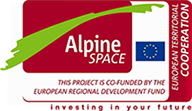p r o d u c t s
(5) Permafrost and water resources management
Rising air temperature has caused the release of highly concentrated meltwater from active rock glaciers. In response to the enhanced release of ions and heavy metals high altitude lakes, which are drained by meltwater from rock glaciers, can experience a substantial change in water chemistry. In particular, the high concentrations of Ni may strongly exceed the limit of drinking water as has been found in meltwater draining from active rock glaciers and glaciers at Schnalstal (Ötztal Alps).
The ice content of alpine permafrost like rock glaciers is still unknown. However, the hydrological regime of active rock glaciers is strongly driven by the amount of water stored as ice in permafrost ground. To study the hydrological regime of active rock glaciers and their response to climate change discharge, water temperature, electrical conductivity and water chemistry (anions, cations, heavy metals) of rock glacier springs were determined at Lazaun (Schnalstal) and compared to glacial meltwater streams and springs not impacted by permafrost. Core drillings were performed at two active rock glaciers (Lazaun – Schnalstal and Rossbänk – Ultental). The cores were documented in detail and are currently beeing analyzed for ice-content, ice-chemistry, stable isotopes and palynology. The drill holes were instrumented with temperature loggers and inclinometers to obtain information on the thermal characteristics and dynamics of the rock glaciers. Core drilling and the hydrological and chemical measurements are supported by sedimentological analysis of the debris mantle of the rock glaciers including clast rock types, grain size, grain size distribution (sorting), rounding and orientation of the clasts on the surface, content of fine-grained matrix, thickness and structure of the debris mantle, mineralogical and geochemical composition and the ice content of the uppermost frozen layer. Additional information on the thickness, internal structure and ice content of active rock glaciers and permafrost ground is achieved by geophysical methods such as ground penetrating radar.
Climate change induced permafrost degradation may have major impacts on ecosystems, landscape stability and on people and their livelihoods.
We recommend that springs derived from glaciers or alpine permafrost should be studied carefully at least for one hydrological year concerning water quality (anions, cations, heavy metals, bacteria), suspension load, temperature and discharge before such springs are used for drinking water supply.


